April 16, 2021
Air Date: April 16, 2021
FULL SHOW
SEGMENTS
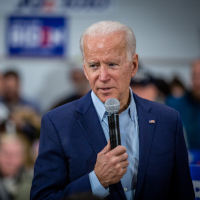
Biden’s Climate Summit
View the page for this story
President Biden has invited 40 world leaders to a virtual Leaders Summit on Climate on April 22, 2021, Earth Day. As the first major diplomatic conference of the Biden administration, this summit positions climate change as a top geopolitical priority for the United States. Alden Meyer of E3G joins Host Steve Curwood to preview the summit and discuss its importance in the international efforts to address climate change. (07:45)
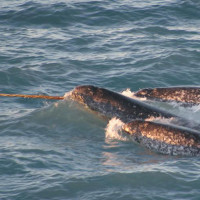
Beyond the Headlines
/ Peter DykstraView the page for this story
In this week's Beyond the Headlines segment, Environmental Health News Editor Peter Dykstra joins Host Bobby Bascomb to discuss how narwhal tusks can help scientists determine past levels of mercury in the ocean. Next, they look at how reforestation efforts face a shortage of seedlings. Finally, they travel back to April 2011 and the deadly Super Outbreak of tornadoes in the US that killed more than 300 people. (05:14)
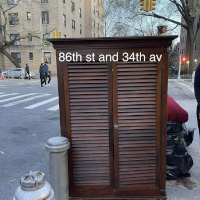
“Stooping” Turns Trash to Treasure
View the page for this story
When people move out or clean up their apartments, many leave discarded items on the stoop or curb for others to claim before the garbage trucks come. Jessica Wolff runs the Instagram page “Stooping In Queens” to help connect this free stuff with new owners and joins Host Bobby Bascomb to discuss her journey with stooping. (10:17)
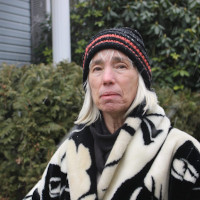
When a Gas Plant Moves in Next Door
/ Julie GrantView the page for this story
With the growth of hydraulic fracturing, cheap natural gas is replacing coal to generate electricity. More than 170 new natural gas power generators are in the works nationwide. And the growing industry is changing the face of communities like Guernsey County in eastern Ohio, where a new gas plant is under construction. Reporter Julie Grant from The Allegheny Front has the story. (04:31)
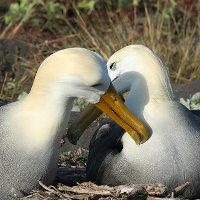
BirdNote®: The Power Of Albatross Partnerships
/ Wenfei TongView the page for this story
Raising a chick is no small feat for Albatrosses and both parents play a vital role. BirdNote®’s Wenfei Tong describes the strong and unique bonds that help albatrosses raise their young. (02:13)
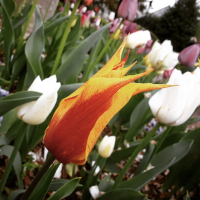
Poetry in the Time of Climate Troubles
View the page for this story
In her poems, Catherine Pierce grapples with unfolding climate disaster and other 21st century perils, and the ways they reframe parenting. She joins Host Steve Curwood to share poems from her books Danger Days and The Tornado Is the World, and to reflect on finding beauty and calls to action during the Anthropocene. (16:43)
Show Credits and Funders
Show Transcript
210416 Transcript
HOSTS: Bobby Bascomb, Steve Curwood
GUESTS: Alden Meyer, Catherine Pierce, Jessica Wolff
REPORTERS: Peter Dykstra, Julie Grant, Wenfei Tong
THEME]
CURWOOD: From PRX – this is Living On Earth.
[THEME]
CURWOOD: I’m Steve Curwood.
BASCOMB: And I’m Bobby Bascomb
For Earth Day president Biden is gathering world leaders for a virtual White House conference on the climate emergency.
MEYER: I think this is a very significant moment because it’s the first major foreign policy initiative of the president of the United States and he has decided to devote that to the climate issue, and try to signal we are really running out of time.
CURWOOD: Also, millennials lean into reducing and recycling with stooping on instagram:
WOLFF: I know there's people who would never even look at a stoop who follow me and suddenly, they like, they got caught up in it because of the trendiness. So I think in that way, we have been able to change some people's buying habits and patterns to have a greater environmental impact.
CURWOOD: That and more this week on Living on Earth – Stick Around!
[NEWSBREAK MUSIC: Boards Of Canada “Zoetrope” from “In A Beautiful Place Out In The Country” (Warp Records 2000)]
[THEME]
Biden’s Climate Summit
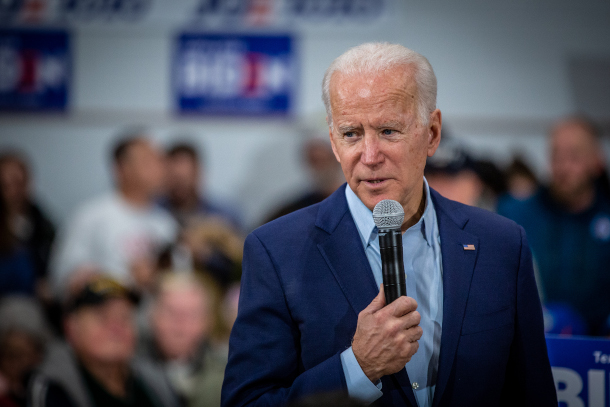
At the April 22 summit or before, President Biden is expected to unveil official US commitments to decrease greenhouse gas emissions by 2030. The new US nationally determined contribution will respond to the requirements of the 2015 Paris Climate Agreement, which the US rejoined 30 days after Mr. Biden came into office. (Photo: Phil Roeder, Flickr, CC BY-SA 2.0)
BASCOMB: From PRX and the Jennifer and Ted Stanley Studios at the University of Massachusetts Boston, this is Living on Earth. I’m Bobby Bascomb.
CURWOOD: And I’m Steve Curwood.
For Earth Day this year President Biden is convening leaders from around the world for a virtual conference on the climate emergency. Mr. Biden’s first major foreign policy initiative is a high wire act when it comes to cooperating with China over the climate. The US is much at odds with the People’s Republic, particularly over human rights, military moves in the South China Sea and pressures on Taiwan and Hong Kong. For more about what’s at stake we are joined now by Alden Meyer, a senior associate of E3G. Welcome back to the program, Alden!
MEYER: Good to be with you again, Steve.
CURWOOD: So come Earth Day, President Biden is hosting this virtual summit on the climate at the White House inviting leaders from around the world. And I think one of the biggest questions is: what is the United States going to put on the table as this nation's Nationally Determined Commitments? What will it be?
MEYER: Well, that's right. Remember, when we entered Paris under President Obama, the US put forward a target for emissions reductions domestically for the year 2025. The Biden administration has announced they will put forward a new target for what we are going to do here in the US by 2030. We are calling on that reduction to be at least 50% below 2005 levels to get us on track to the net zero emissions commitment that the President has made for 2050.
CURWOOD: What are the odds, Alden? Do you think that we'll see that number from the Biden administration?
MEYER: Well, I think we have a good chance. A number of analyses by environmental groups, business organizations, academic think tanks, and others show that a reduction of that magnitude is achievable. It's cost effective, it would have tremendous health benefits, and it would bring economic benefits to the US and employ millions of people.
CURWOOD: Now, this is a summit of leaders from around the world. I'm curious as to who is expected to be there.
MEYER: Well, the invitations have gone out to 40 countries. Of course, these include all of the major economies, but it also includes a number of vulnerable countries such as Antigua and Barbuda, Bangladesh, Bhutan, Marshall Islands. So this is going to be a pretty broad discussion over two days on a range of topics, including not only what countries can do in terms of raising their ambition, but how we need to cooperate to innovate and rapidly deploy technologies needed to get us to net zero emissions by mid century.
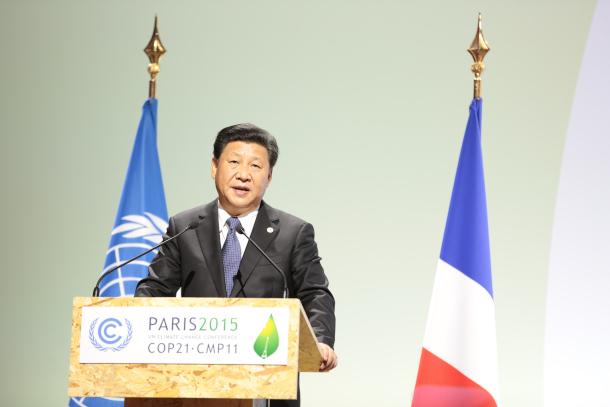
President Xi Jinping of China has not formally accepted the invitation to the White House Climate Leaders’ Summit but is expected to attend. (Photo: Unclimatechange, Flickr, CC BY 2.0)
CURWOOD: What will China's engagement look like at this summit? Of course, the United States and China aren't exactly best friends right now, diplomatically. And yet, we're the top two emitters of carbon today on the planet.
MEYER: That's right. And and that's one of the unanswered questions a week out from the summit. China has yet to formally accept the invitation for President Xi to attend the summit. All observers believe that ultimately, he will accept. And of course, China has not yet fully lived into the commitment that President Xi made last September, at the United Nations General Assembly to reach net zero carbon dioxide emissions in China no later than 2060. Their most recent five year plan unveiled last month really doesn't have the kind of increases near term ambition that we need to see to put them on that trajectory, and they are still building coal plants domestically. So the big question is, will China signal any near term changes in its climate strategy before the summit? And if so, will they bring that increased ambition into the summit as a marker of how serious they are about providing leadership on this issue?
CURWOOD: What do we expect to hear at the White House Summit on Earth Day on the climate with the leaders from those countries that are most vulnerable now from climate disruption?
MEYER: Well, I think they're going to make the case that the world needs to step up its assistance to their countries on adaptation, on resilience investments, on coping with the climate impacts they are experiencing. They're going to particularly put pressure on the US and other developed countries to scale up climate finance, and to make sure that a larger share of that financial assistance goes towards adaptation. They're shooting for 50% of climate finance assistance to be devoted to adaptation and dealing with climate impacts as opposed to the roughly 20 to 25% share of finance that's going in that direction now.
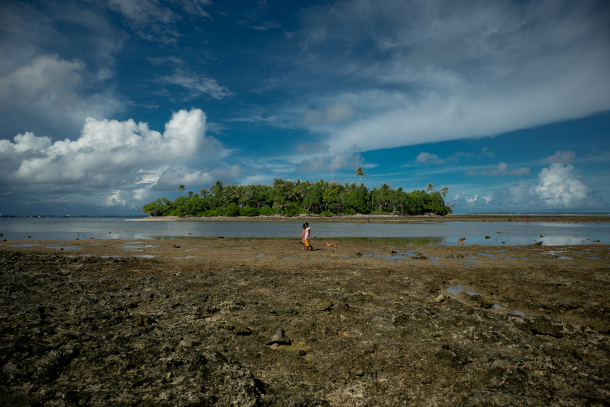
The Marshall Islands is one of the nations most affected by climate change. The Marshallese government and leaders from other vulnerable nations are expected to press the United States and other top emitters for adaptation and compensation for the damage already done. (Photo: Asian Development Bank, Flickr, CC BY-SA 2.0)
CURWOOD: Loss and damage is bound to be a crucial and controversial topic at this summit. Explain for us briefly, what is loss and damage and how will it play out do you think in this White House climate summit?
MEYER: Well, loss and damage is basically the unavoidable impacts of climate change after you've done as much as you can on mitigation and adaptation. There are some things you just can't head off, like the impacts of sea level rise of extreme weather events, such as hurricanes and typhoons. So you need help for countries that are experiencing those climate impacts to deal with them. Some of the developing countries and some of the International non-governmental groups have said that the US and other Western economies that are largely responsible for historical emissions of greenhouse gases have a responsibility to compensate these countries for the damage they're experiencing. And of course, you're talking here about potentially hundreds of billions of dollars a year in costs of these impacts. So it's been something that the US, Europe, other developed countries have been very reluctant to engage in, but I think they will have to deal with that. It is an issue the vulnerable countries and others will put front and center on the agenda. And there needs to be an adult discussion about what we're going to do about it going forward.
CURWOOD: I'm inferring from that that hasn't always been very polite. Has there been food fights over this Alden?
MEYER: There have been tremendous food fights over this. I recall back at the Conference of the Parties meeting in Doha, Qatar in 2012. The entire conference almost collapsed because of a fight between the US and the alliance of small island states on the last night of the summit. It also was a tough issue in the run up to Paris. It is a difficult issue, but it is something we have to come to grips with. And I believe that we'll see some signals from the Biden Harris administration, that as long as we stay away from expressing it in terms of compensation or liability for past emissions, that the US may be willing to step up and provide more assistance going forward.
CURWOOD: Alden, you've been covering international climate negotiations for, well, north of 30 years I think at this point. What, if anything, has you excited about this summit?
MEYER: Well I think this is a very significant moment, because it's the first major foreign policy initiative of the President of the United States. And he's decided to devote that to the climate issue. The US is convening leaders from around the world to put this front and center on the geopolitical agenda, and try to signal that we're really running out of time to get the actions we need to live into the commitments countries made five years ago in Paris. I think what gives me hope is that we're realizing we have the architecture in place with a Paris agreement to get to where we need to go. And it's really no longer about negotiation of international treaties. It's about implementation, as Nike might say, just do it. The good news is I think countries are focused on that now and the US is exerting a lot of pressure on other countries like Japan, South Korea, Canada and others to live in to their commitments to get their emissions to net zero by mid century. It's too bad this didn't happen 10, 20, or 25 years ago, we could have done a lot more, but I am hopeful that this is going to represent a major step forward.
CURWOOD: Alden Meyer is a senior associate with E3G, thanks so much for taking the time with us.
MEYER: Thanks, Steve. It was great to be with you again.
Related links:
- The White House | “President Biden Invites 40 World Leaders to Leaders Summit on Climate”
- The New York Times | “Biden Wants Leaders to Make Climate Commitments for Earth Day”
- Vox | “What A Fair Climate Target Looks Like for the US, The Largest Historical Carbon Emitter”
[MUSIC: Gary Burton, “O Grande Amor” by Vinicius de Moraes and Antonio Carlos Jobim, live at KPLU]
Beyond the Headlines
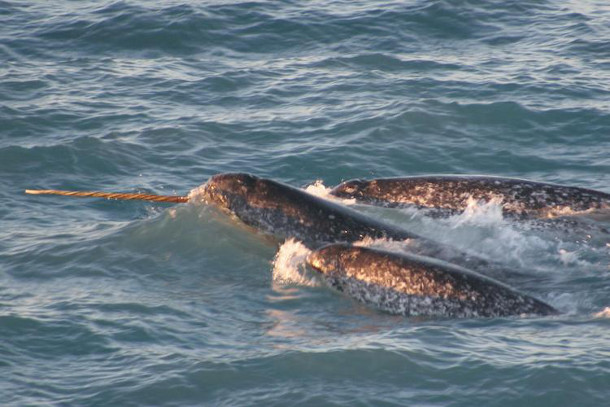
Arctic sea ice melts due to the warming climate affecting Arctic animals like Narwhals. Scientists have recorded that Narwhal tusks provide evidence of s significant increase of mercury in the Arctic starting the year 2000. (Photo: Courtesy of Kristin Laidre, NOAA)
BASCOMB: Well, it's time for a look beyond the headlines now with Peter Dykstra. Peter's an editor with Environmental Health News. That's ehn.org and dailyclimate.org. Hey there, Peter, what do you have for us this week?
DYKSTRA: Well hi Bobby. We're going to talk first about narwhals. These mystical creatures that look like they're fiction rather than fact. Narwhals are small whales, marine mammals live in the Arctic, and the males have a tusk that can grow up to 10 feet long. They look like saltwater unicorns and scientists have discovered that those tusks can reveal things about changes in the Arctic, via the narwhals diet. So just like rings of a tree, tusks of a narwhal can tell you a lot about what they eat. And that tells you a lot about how the Arctic is changing.
BASCOMB: And so what have scientists been able to learn from their tusks?
DYKSTRA: In about three decades worth of research they've noticed changes in the amount of mercury that can be found in narwhal tusks. Part of that is due for at least part of the time of the last 30 years to emissions from coal power plants that can travel from all over the world, even Southeast Asia, to drop mercury into Arctic waters in addition to everywhere else.
BASCOMB: Yeah, it's such a remote part of the world. But yet, of course, pollution travels everywhere.
DYKSTRA: It does and particularly persistent pollution, like some of the organic chemicals, and Mercury sources that come from the industrialized world.
BASCOMB: And of course, mercury can have all sorts of health problems from cognitive functioning and to reproduction. I mean, it seems like a probably a concern.
DYKSTRA: A big concern.
BASCOMB: Yeah, well, what else do you have for us this week?
DYKSTRA: Some maybe bad news on a generally good news topic. Reforestation is cool. It's at least a partial solution to the amount of trees that we've lost the amount of carbon mitigation that we need around the world. But as reforestation kicks up, you may recall that former President Trump even endorsed something called the Trillion Trees Initiative for replanting trees around the world. Everybody forgot something about this. In order to plant trees, you need seedlings and in order to have seedlings you need seeds. And we haven't been collecting the seeds nearly fast enough.
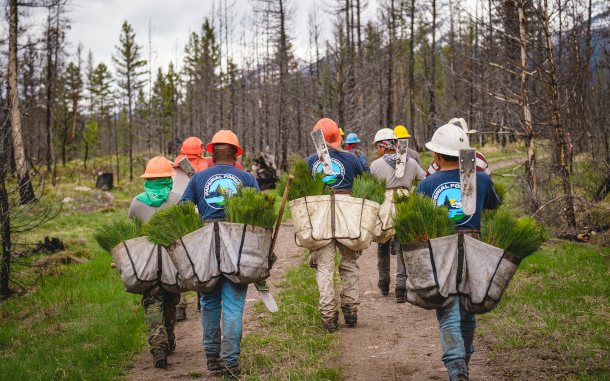
According to a study published in Frontiers in Forest and Global Change the country only produces 1.3 billion seedlings a year, which means the US is lacking about one third of the seedlings necessary to carry out the plan of reforesting 133 million acres by 2040. (Photo: Dave Gardner, Flickr, National Forest, Public Domain)
BASCOMB: Ah details. Why are we so slow at getting the seeds that we need?
DYKSTRA: Well, there was a study earlier this year in the journal Frontiers in Forest and Global Change. It was authored by scientists from the US government, from universities and from nonprofits. They said that here in the US, we're about 2 billion seedlings a year short of where we want to get to even meet half of our reforesting potential. They estimated that there are 133 million acres to reforest by the year 2040. That's 133 million acres a year, that would require 34 billion seedlings, and we ain't got the seeds, because they have to be collected by people and there are not enough people on the ground doing this key work.
BASCOMB: And what about the trees? Are they producing seeds in the numbers that we would need?
DYKSTRA: There's some evidence that trees in some parts of the world are not producing the same number of quality seeds. So there could be two obstacles to reforestation, as a global fix to help with climate change and to help with habitat loss.
BASCOMB: Well, gosh, I hope we can figure something out we certainly need those trees. Alright, Peter, and what do you have for us from the history books this week?
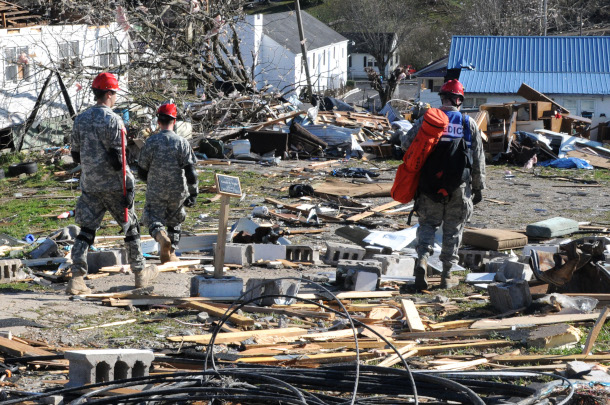
Kentucky’s National Guard searches for survivors as part of a tornado response in March of 2012. (Photo: Spc. David Bolton, 133rd Mobile Public Affairs Detachment, Kentucky National Guard, Public Domain)
DYKSTRA: A 10th anniversary 10 years ago, from mid April into the month of May, there were three immense tornado outbreaks in tornado alley in the US and as far east as North Carolina outside the traditional tornado belt Hundreds of tornadoes well over 300 deaths. Some of those tornadoes were major ones F-3 and above. And the moral of that story is that 10 years ago, 300 plus deaths. If this had happened 50 or 60 or 100 years ago, it might have been a death toll in the thousands because we didn't have the weather diagnostics, and we didn't have the communication through radio and TV back then. The death toll for tornadoes has gone way down in the last few decades.
BASCOMB: Well, that's certainly good news. Thanks, Peter. Peter Dykstra is an editor with environmental health news that's ehn.org and dailyclimate.org. We'll talk to you again real soon.
DYKSTRA: All right, Bobby, thanks a lot. Talk to you soon.
BASCOMB: And there's more of these stories on the Living on Earth website. That's LOE.org.
Related links:
- SciTechDaily | “Narwhal Spiraled Tusks Reveal Toxic Mercury Exposure Related to Climate Change”
- Wired | “Reforestation is Great! But We're Running Out of Seeds”
- NOAA | “On This Day: 2011 Tornado Super Outbreak”
[MUSIC: Kyle James McCann, “Somewhere Over the Rainbow” by Harold Arlen and Yip Harburg]
CURWOOD: Join us for the next Living on Earth Book Club! On April 21st at noon Eastern we will chat with Maria Ivanova, author of “The Untold Story of the World's Leading Environmental Institution: UNEP at Fifty. Maria shares how the fiftieth anniversary of the United Nations Environment Program is a chance to reinvent quote "the world's environmental conscience." Register for this free event at the Living on Earth website, loe.org. Just click on "Events" at the top of the page.
[MUSIC: Kyle James McCann, “Somewhere Over the Rainbow” by Harold Arlen and Yip Harburg]
CURWOOD: Coming up – Fracking for natural gas is transforming rural life in parts of Appalachia. Keep listening to Living on Earth.
ANNOUNCER: Support for Living on Earth comes from Sailors for the Sea and Oceana. Helping boaters race clean, sail green and protect the seas they love. More information at sailors for the sea dot org.
[CUTAWAY MUSIC: Rikard From “It’s an Upright Thing”]
“Stooping” Turns Trash to Treasure

A recent Stooping in Queens post (Photo: courtesy of Jessica Wolff, @StoopinginQueens)
BASCOMB: It’s Living on Earth, I’m Bobby Bascomb
CURWOOD: And I’m Steve Curwood
BASCOMB: Hey Steve, have you ever put anything you don’t need any more out on the street in the hope that someone will pick it up or found something you could use still sitting on the curb?
CURWOOD: Oh yeah both ways in fact back in college that’s how I furnished my first apartment.
BASCOMB: Yeah right! You know I used to live near a university in Boston and at the end of the school year the sidewalks were full of unwanted furniture and such.
CURWOOD: Surely a sign that summer is on the way. Huh?
BASCOMB: Oh yeah totally. But you know finding free stuff on the street isn’t just for college students. And according to our next guest New York City is entering a Golden Age for stooping.
CURWOOD: Stooping?
BASCOMB: In many cities stoops are the little spots in front of your door, maybe at the top of a couple steps where people hang out in the summer and put out the things they no longer need for other people to pick them up. And in New York it’s become really trendy, especially during the pandemic. I talked with Jessica Wolff about it, she runs the Instagram page Stooping in Queens.

Here’s a stoop in Greenwich Village, NYC. These stoops have created a “stoop culture” where people can hang out on each other’s stoops and display discarded items for others to grab. (Photo: Spencer Means, Flickr, CC BY-SA 2.0
WOLFF: The term stooping really relates to cityscapes where they have stoops in front of apartment buildings, where you can sit and hang out because there's a whole stoop culture. When you're stooping, you're finding things that people leave near, next to, or on their stoops. People direct message me on Instagram, and they'll send me a picture of an item, or multiple items, and the location. And then, maybe part of the lure is my strange captions, I try to be really humorous. I really want the whole thing to be like this happy, uplifting community.
BASCOMB: How do you think stooping became kind of this cool activity now? It's become something that people are really excited to be a part of.
WOLFF: Yeah, stooping has been around forever. I mean, stooping nowadays has really become trendy and cool, and I think that's partially because of social media. There's a lot of different social media accounts on Facebook and Instagram, where they post pictures or they're like, buy-sell-swap groups, and they you have notifications of things that are being discarded. But I think social media has a very millennial demographic. And the reason why stooping has become cool, is because of the association with that younger target audience. And it just kind of grabbed on during the pandemic last year, it really was relatable. The pictures and the photography, sometimes things look really aesthetic, and I think that makes them really attractive. And then it just became part of this culture, especially like the city culture, where people were just going around and they started doing it with their friends. They started doing it because it was this adventure, it was thrilling.

Here is a refurbished table and marble shelves, both stooped items from Queens, NYC. (Photo: Courtesy of Jessica Wolff, @StoopingInQueens)
BASCOMB: Well, how has stooping changed in the last year or so with the COVID virus, if at all?
WOLFF: Yeah, that has drastically changed the world of stooping. Before, stooping wasn't cool. But I think the fact that there are so many things on the stoop now, because people are moving, not just locally, but cross country moves, international moves, and they don't have time to pack up their things, they have an apartment full of IKEA, they don't really want to take it with them. And you just see on my page, entire apartments that are cleared out on the street. So I don't think that's really been, what stooping has been about prior to the pandemic. People weren't just abandoning their homes, and leaving everything they own on the curb. So I really think that it's created a lot more waste, then then there was before. And I think having media pages like this has really given it a lot of visibility.
BASCOMB: So there's a lot more stuff out there. And at the same time, I would think people have a lot more time on their hands to go around looking for things and taking the time to improve it or to refinish it in a way that's going to work for them.
WOLFF: Yeah, based on the times that I get DMs and the amount of things that I get messages for, I think people have a lot of time on their hands. You know, if you have a backyard or something, a lot of Queens apartments have backyards, and they also have their own cars, they have backyards and parking spaces. So if you have time on your hands, and you know your Zoom meeting is over, and you see a really cool table on my page, you probably can to go out and get it. So I know someone who has a backyard and they have a shed there with tools because they're a DIY person, and they've gotten a lot of things and refinished them to give to their cousins and their aunts. Their whole family has received stooped gifts that they've rescued and resuscitated. People have started businesses because of job loss. If they have these kinds of skills for woodworking or restoration, they've actually started Instagram companies where they renovate furniture and resell it. There's a lot of delivery services that have started as well, who deliver things from stoop to stoop. They will pick up an item that you tagged them in, they'll go to the location, they'll try to get it for you. And if they can secure the goods before another stooper, they will deliver it to your apartment, same day or next day. So a lot of those companies have also started.

Here are a few stooped items as they are found on the street. This ornate rug and modern table were both claimed before they made it to the landfill. (Photo: Courtesy of Jessica Wolff, @StoopingInQueens)
BASCOMB: Wow, it's amazing, the entrepreneurial spirit associated with stooping, I love it. Well, what is the potential, do you think, for stooping and this kind of thing to bring people together? You know, I'm thinking both of the people that maybe go out stooping together and participate in your Instagram feed, but also the relationship between the people putting these items out and the people picking them up.
WOLFF: Relationships have formed because of stooping, friendships. There was a really cool steel lamp and one of my followers took it in and she didn't want it and she just said "This is available, I have it. You know, if you want to come pick it up, please DM me." And so I posted it, and another stooper came. And they chatted for like 30 minutes on the stoop, they just had this nice conversation, and they're friends now. They send their stooping success stories to each other. So I definitely think the potential for this community outreach, and this friendship and respect is huge. And it's definitely bringing people together. There are not stoop wars, no one is physically fighting each other or getting upset with each other over missing out on an item. So I think there's this helpful, friendly air to the whole thing, which makes it a really positive and uplifting community.
BASCOMB: Now, obviously, if you are getting free things on the street, you're not buying something new and that free thing isn't going into a landfill. To what degree do you think environmental concerns are really on people's minds? Or have you looked into it all, you know, how many carbon emissions can be avoided and landfill space not taken up?
WOLFF: I think this is a very complex question. And it has a lot of different components because we're working together to try to reduce landfill waste. You know, we're taking orders away from from stores, but I think it also has a component of the way that we live. And we live in this way where overconsumption is something that people don't even realize that they do. We just don't need the amount of stuff that we're buying. More importantly, we are reducing carbon emissions. I know two months ago that my account had saved over 1 million pounds of landfill waste from Queens. You know, hopefully this also makes people rethink their buying habits. I know there's people who would never even look at a stoop who follow me and suddenly, they like, they got caught up in it because of the trendiness. So I think in that way, we have been able to change some people's buying habits and patterns to have a greater environmental impact.

Stooped items, with a little bit of cleanup, can be ready to be on proud display in your home. Here’s another stooping success of both the wooden lamp-table, and blue velvet couch. (Photo: Courtesy of Jessica Wolff, @StoopingInQueens)
BASCOMB: Well, in addition to telling people where you can find cool stuff, you also have success stories on your Instagram feed that really show the trash to treasure potential for things. Can you tell us a couple of your favorite examples of taking something found on the street and making it into something really, really unique and beautiful?
WOLFF: Yeah, this is definitely one of the most exciting parts of the stoop journey. One of my recent followers, he got this antique wooden chest with gold fixtures on it, and it looked pretty beat up and dusty on the street. And he took it home and he restored it. And it turns out, it's this Chinese trunk and has an entire manuscript written inside, which I couldn't even see from the initial picture that I posted. So he restored it, and it's in his living room now, it's like a plant stand. But it was beautiful, you know, from start to finish, it was a dusty, discarded thing you would never know that it was, first of all valuable, I think its valued over $400. And secondly, it's just a nice aesthetic too, so that was a really cool one.
BASCOMB: I saw that on your Instagram feed and it's just beautiful. It makes me feel rather inadequate. I look at this thing on the street and would rip pass right by it. But then that somebody can take that and turn it into something that's so exquisite. You'd expect it you know, spend a lot of money in a store on something that looks so so nice. I'm envious of people that have those skills, because I do not.
WOLFF: Yeah, I am too. I can't do any of that.
BASCOMB: Well, you host an Instagram page @StoopingInQueens. But what about the rest of the country or the world for that matter? Is this a trend that you think could be taking off in other places?
WOLFF: Yeah, a lot of other stooping pages have started and reached out to me. And a lot of my stoopers are not in Queens. There are a couple of pages that started in LA, there was a page that started in Virginia. The trendiness is not, it's not limited. Maybe it's like a community need that's bringing people a lot of joy.
BASCOMB: Jessica Wolff works in sustainable fashion and run @StoopingInQueens on Instagram. Jessica, thank you so much for all of these stooping stories.
WOLFF: Not only has it been a pleasure, it's been really fun. Thanks for having me.
Related links:
- The @StoopingInQueens Instagram Account
- The New York Times | “The Golden Age of Free Stuff Is Upon Us”
- The New York Post | “New Yorkers Revel in Virus-Fueled Gold Mine of Free Street Furniture”
- TimeOut | “The Instagram Phenomenon That Has New Yorkers Scouring the City’s Sidewalks”
[MUSIC: Doreen Ketchens, Lawrence Ketchens and Paul Kemnitz, “This Train” live at WWOZ in 2014, traditional African-American spiritual]
When a Gas Plant Moves in Next Door
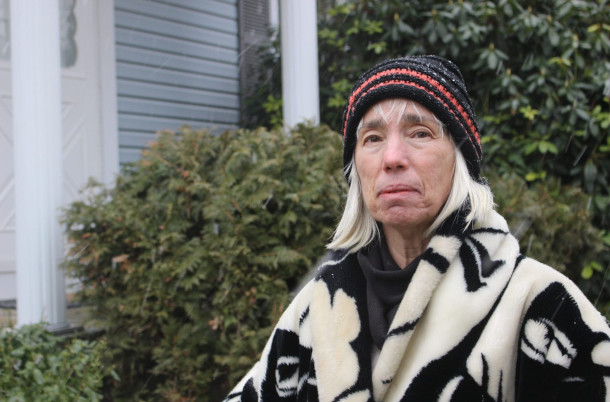
Judy Burger of Belmont County, Ohio stands next to her home. Across the road, two fracking waste injection wells are being built. Judy is concerned about noise and pollution from constant truck traffic. (Photo: Julie Grant, Allegheny Front)
CURWOOD: In certain parts of the country if one drills a deep hole and pumps in liquids under high pressure the hydraulic forces can crack the rocks and release natural gas. Fracking has been a cheap way to extract domestic fossil fuel, and nationwide some 170 new natural gas electric power generators are in the works. For some it means jobs, but for others, as the Allegheny Front’s Julie Grant reports form Guernsey County in eastern Ohio, it can make for nightmare neighbors.
GRANT: Kevin and Marlene young built their house in the country so they had space for horses.
YOUNG: I was raised around horses. That's my love.
GRANT: Their horses aren't just pets. They built a half mile track to train them as resources and they've won 10s of 1000s of dollars.
YOUNG: So we're getting ready to retire. I thought we hat it handled. I even got it all paid for.
GRANT: Visiting them now things dont seem handled. Big trucks drive past the house during the day long. The farm field next door has become an industrial construction site. The air is often filled with dust there's a thick layer of it on theri new truck. In the summer of 2019 Caithness Energy started building one of the largest gas plants of this kind in the country. Theres already a pipeline that will run natural gas from Pennsylvania and Ohio into the site. The Guernsey Power Station will generate enough power for 1.5 million homes. But the Youngs don't want t o live next door to it. Like other who live nearby they say the construction has caused cracks in their walls.
YOUNG: My dishes shake, my bedroom is on the second floor. And it's like you put a quarter in one of them beds that's how it vibrates.
GRANT: Caithness declined to comment about claims that it's construction caused damage. The Youngs have stopped training their horses, even putting them on respirators. Marlene falls apart when she talks about her best horse, Creekside Pete.
YOUNG: (crying) I had to sell it to get it out of here because of this stuff going on.
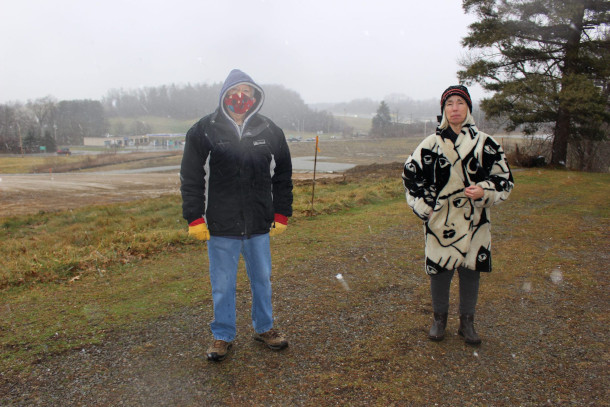
Judy Burger and neighbor Tom Rattine stand in front of the construction site for the fracking waste injection wells. (Photo: Julie Grant, Allegheny Front)
GRANT: The Youngs want Caithness to buy them out. The company declined to comment. County records show it bought homes from three other families in the neighborhood. Meanwhile, many people in the area see the new gas plant as hope for the region's future. When Caithness came here in 2016 Norm Blanchard Economic Development Director for the region was thrilled by the idea of a $1.6 billion plant.
BLANCHARD: For us it was almost like a carnival coming to town.
GRANT: The company is spending millions to prepare the site and has promised $42 million to the local school system over 30 years. It promised 1,000 construction jobs when it opens in 2022. It will employ 30 high tech workers. Blanchard wishes it was more but he's not complaining. As he stands along the highway looking at the huge construction site. He says all the cranes here are like a billboard for economic development.
Something like this to be able to locate it here puts you on the map.
YOUNG: Like many areas near power plants the poverty rate here is high. Environmental attorney Dave Altman says many communities jumped at the money and jobs offered by deep pocketed energy companies.
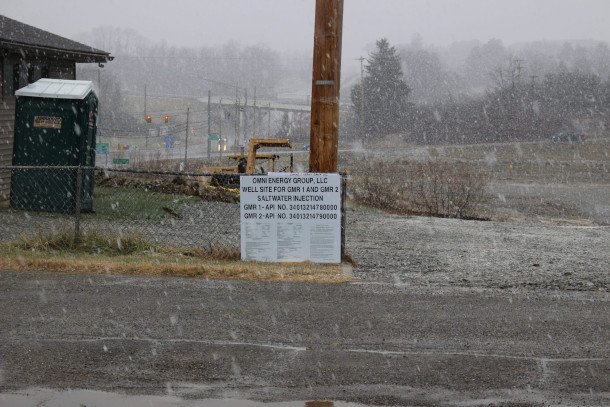
Pictured is the construction site for OMNI Energy Group, near an exit of the I-70 in Belmont County. (Photo: Julie Grant, Allegheny Front)
ALTMAN: Local governments somewhat understandably at times, blindly accept promises and operate in denial to the collateral damage to the people who are left behind.
GRANT: Kevin and Marlene Young say they haven't gotten help from the government on any level. There are no local zoning codes or land use restrictions and while Ohio has strict laws ensuring wind turbines aren't built too close to homes. The state has no such requirement for gas plants. At the federal level, the Trump administration removed a rule in Ohio's federal air quality plan in December, that gives citizens some protection from environmental nuisances, like dust and odors that endanger health and property.
ALTMAN: They would have been able for 40 years to take that evidence in the court. And now they won't be able to do that directly anymore.
GRANT: In an email Ohio EPA said it still retains authority and will enforce the nuisance rule. The power plant has its permit from the agency with limits on pollutants like volatile organic compounds and particulate matter. Ohio EPA said pollution levels outside the facility will not cause harm, but the Youngs don't want to wait to find out.
YOUNG: I'd just as soon go and get us a little trailer a little place someplace clear out of the state to get away from this whole place.
GRANT: The family has recently retained a lawyer.
CURWOOD: Julie Grant’s story comes to us courtesy of The Allegheny Front
Related links:
- Allegheny Front | “More Ohioans Want Some Say in Siting Drilling Waste Injection Wells”
- More on Julie Grant
[BIRDNOTE THEME]
BirdNote®: The Power Of Albatross Partnerships
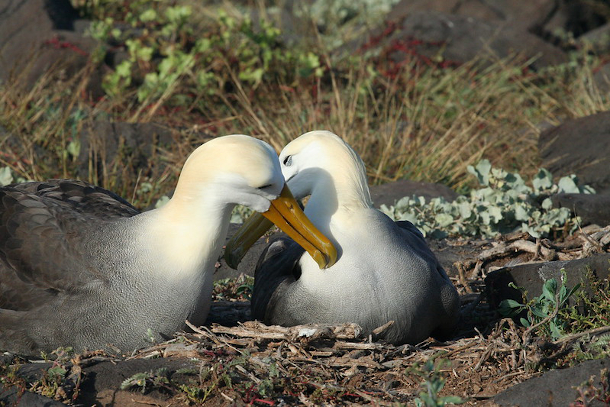
A Waved Albatross pair (Photo: Wildlife Travel, CC)
BASCOMB: Most bird species are diligent parents, sitting on their precious eggs through weeks of incubation despite rain and wind. And if there were a contest for the most doting of bird parents the albatross might just be the winner. BirdNote’s Wenfei Tong has more.
BirdNote®
The Power of Albatross Partnerships
TONG: For most albatross species, raising a chick is a real challenge. Waved Albatrosses produce such slow-growing, needy offspring that females lay only a single egg every two years. And both parents need to share the load until youngsters can hunt on their own.
[Waved Albatross https://macaulaylibrary.org/asset/203698321#_ga=2.41689515.888524604.16… 0:16-:19]
Albatrosses tend to pair for life, and it can take a while to find the right partner — so some species don’t start breeding until they are 10 years old, with some individuals even waiting until they are 20. Reunited pairs go through an elaborate, synchronized ritual of braying, wing spreading, and bill tapping to reaffirm their bonds before getting down to the business of breeding.
[Wandering Albatross https://macaulaylibrary.org/asset/116338191#_ga=2.265744463.1576298121… 3:14-3:18]
In Hawaii, biologists were puzzled to find that some Laysan Albatross pairs had not one, but two eggs. Then they found that some of the birds going so faithfully through the ritualized series of courtship displays were both female.
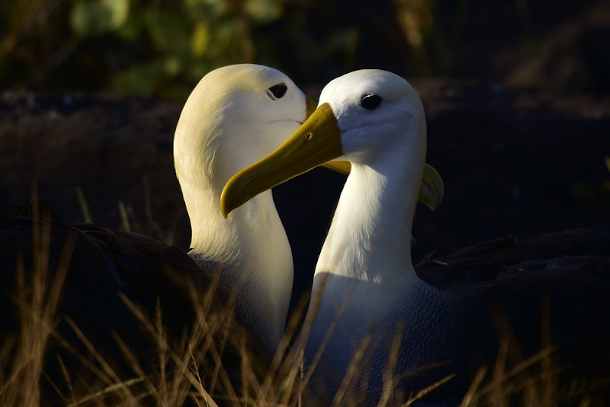
Albatrosses tend to mate for life and can live more than 50 years. (Photo: Sidney Bragg, CC)
[Laysan Albatrosses https://macaulaylibrary.org/asset/959#_ga=2.267683079.888524604.1609180… :24-:31]
Although the eggs were fertilized by males that had since died or were from other pairs, the females were bonded to each other. Many of these female couples remain together for years. They can’t successfully raise both offspring, but their combined efforts are necessary to raise one chick.
[Juvenile Laysan Albatross https://macaulaylibrary.org/asset/32669#_ga=2.101412488.888524604.16091… :06-:12]
###
Written by Wenfei Tong
Senior Producer: John Kessler
Production Manager: Allison Wilson
Producer: Mark Bramhill
Associate Producer: Ellen Blackstone
Bird sounds provided by The Macaulay Library of Natural Sounds at the Cornell Lab of Ornithology, Ithaca, New York. Waved Albatross ML203698321 S. Olmstead, Laysan Albatross ML959 E. Booth, Laysan Juvenile ML 32669 C. Robbins
BirdNote’s theme was composed and played by Nancy Rumbel and John Kessler.
© 2021 BirdNote March 2021 Narrator: Wenfei Tong
ID# albatross-03-2021-03-26 albatross-03
https://www.birdnote.org/listen/shows/power-albatross-partnerships
BASCOMB: For pictures soar on over to the Living on Earth website, LOE dot org.
Related links:
- Find this story and many more on the BirdNote® website
- Learn more about the Waved Albatross
- Learn more about the Laysan Albatross
[MUSIC: Emmet Cohen “Dardanella”, Mack Avenue Records II]
CURWOOD: Coming up – poetry to help us understand our place in the climate emergency. Keep listening to Living on Earth.
ANNOUNCER: Funding for Living on Earth comes from you, our listeners, and United Technologies, combining passion for science with engineering to create solutions designed for sustainability in aerospace, building industries, and food refrigeration.
[CUTAWAY MUSIC: The Saturday Night Live Band, "Boiler Room Inspection" on The Saturday Night Live Band - Live From New York! by BUddy Williams/arr: Leon Pendarvis, Pro Jazz Records]
Poetry in the Time of Climate Troubles

Poet Catherine Pierce confronts the climate emergency head-on in her work, and even finds beauty within it. (Photo: Catherine Pierce)
BASCOMB: It’s Living on Earth I’m Bobby Bascomb
CURWOOD: And I’m Steve Curwood
We’re celebrating Poetry Month this year with Catherine Pierce. This award-winning author of poetry collections including Famous Last Words and Danger Days teaches creative writing at Mississippi State University. Catherine Pierce joins me now from Rehoboth, Delaware. Welcome to Living on Earth!
PIERCE: Thank you so much for having me on.
CURWOOD: Our pleasure. So Catherine, environmental disaster seems to be, well, can I call it a muse of sorts for you? Tell me, tell me why is that?
PIERCE: [LAUGHS] That's a great question, a muse! Yeah, I guess, I mean, I guess we could call it that. It's a terrifying muse, but I guess we could call it that. I've become increasingly impacted, just in my day to day life, by extreme weather, by these things that are changing in the way that I think a lot of us have. I live in Mississippi, I'm in Delaware right now, but I teach at Mississippi State, and I've been living there for 14 years. And we've had, you know, more and more tornadoes, tornadic weather, strong storm systems coming up through the Gulf. And people's lives have just been completely disrupted and sometimes destroyed by these things. And so that's part of it, is having had some very real experiences, very close calls with tornadoes, and knowing a lot of people who have had homes destroyed, or who have lost loved ones because of these things. And I also became a mother while I was living in Mississippi, I have two kids, and we try to get outside a lot, we try to experience the outside world as much as we can. And it's a thing that brings us a lot of joy. But there's something about trying to impart that joy to my children; it's always kind of tinged with this sadness, or this feeling of guilt as I think about how this world as we know it is shifting every single day. And what's going to be left by the time they're my age?
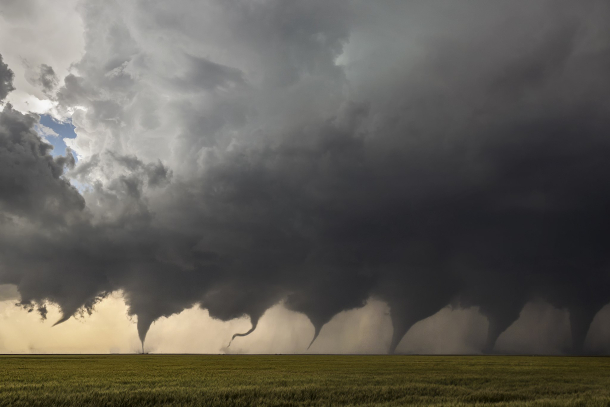
Photomontage of the evolution of a tornado: Composite of eight images shot in two sequences as a tornado formed north of Minneola, Kansas on May 24, 2016. (Image: JasonWeingart, Wikimedia Commons CC BY-SA 4.0)
CURWOOD: Now, if you grew up near the Chesapeake, then you must have been well aware of nature as a child, as a young person coming up, what's changed about your perception of the environment now, as an adult in these times of climate disruption?
PIERCE: I mean, one thing that I've noticed, is the fact that small things are different. Things like the fact that when I was growing up, we had snow pretty regularly, you know, up in Wilmington, Delaware, where I grew up. And now there's less of that. I mean, we're getting extreme snow, we're getting crisis snow. But we're not getting as much of that sort of reliable, pleasant, you know, several inches, close-the-school-for-a-day kind of snow. And so you know, you see these little changes. Or I see things like, I teach at Mississippi State, and we have this beautiful campus with all these beautiful blooming trees. And a couple of years ago, I remember walking outside and seeing that one of our trees near the English building was blooming, but it was the fall, it was a tree that should be blooming in the spring. And the tree was confused, something about the weather had, had confused it. So and you know, you see these things occasionally. And then thinking about just extreme weather popping up throughout the country, the tornadoes that are getting increasingly bad in the Deep South, and also in the Midwest; the extreme weather that we saw in Texas not so long ago. All these things, all of this extreme weather that's coming through, all as a result of disruption and of climate crisis. And these are things that, you know, again, I'm observing from the perspective of just a person, you know, living my life. And I'm not a meteorologist, I'm not a scientist, but I'm paying attention. And I'm aware of the way the sun feels on my face. And I'm aware of the way the wind feels when I step outside. And they're subtle shifts, but they're very real and if you look at the data, all the stats are there. But I think we can see it in very day to day ways as well.
CURWOOD: You have a poem that I'd like to ask you to read that really seems to capture, well, kind of the element of, of exhaustion of dealing with constant climate disruption now. It's called, If/When.

On Sept. 4, 2019, a chain of tropical cyclones lined up across the Western Hemisphere. (Image: NASA Earth Observatory/Joshua Stevens; NOAA National Environmental Satellite, Data, and Information Service)
PIERCE: Yeah, this poem was first published in the Southern Review.
If/When.
The poem I planned to write
was about last week’s hurricane,
about how I live in Mississippi,
not that far from the storm’s rages,
and how even still we felt
nothing here, nothing at all.
That was going to be the ending,
because I wanted to make a point
about how easy it is to ignore
disaster when it’s not churning
directly over your town, and I was hoping
a reader might then extrapolate
a larger point about disturbance
and proximity, like how politicians
are always saying they used to oppose X
until some terrible Y happened
to their daughters, and it seems
to me we’re requiring an awful lot
from daughters these days. Sons, too.
This week a message from my kids’
school district included the phrase if/when
a lockdown is ever necessary. The reason
I’m writing this poem instead
of the one I’d planned is that I keep
thinking about that email and also
now the hurricane was a week ago
and there’s a new disturbance
forming near the Bahamas. And
last night Sioux Falls was tornado-
shredded and in Sterling, Colorado,
egg-size hail pummeled windshields,
and I guess what I’m saying is, why bother
with one poem about one hurricane,
one email? There will be more,
and there will be more,
and there will be more until
there is nothing left. The thing
about the poem I was going to write
is that it would have been a lie.
That nonsense about how we don’t
feel it here. We feel it everywhere,
don’t we? Dear daughter, dear son,
dear someone’s something, we’re well
past the if and into the when.
Talk about proximity—
some days I wear the world
like a skin. I am tired of waiting
for extrapolation. Let us all
be disturbances now.
CURWOOD: Yeah. So what are the climate impacts that have made perhaps the deepest impressions on you?
PIERCE: Certainly, for me, it's been the tornadoes that I've seen living in Mississippi. And we see tornadoes every year, we have tornado warnings regularly in the spring and fall especially. And, you know, the sirens go off, and everyone's in their bathtubs, because we don't have basements there because the, the water level is too high. So everyone just hunkers down in their bathtubs and hopes for the best. But that for me has had a huge impact. In 2011, that was when the tornado super outbreak occurred, if you remember that, that really decimated a lot of the Deep South. More than 300 people were killed that day, and thousands more were injured. And on that day, I happened to be traveling with my husband and our infant son -- I had just had my first son, he was four months old -- and we were driving. We knew the weather was supposed to be bad, but we didn't really have a sense of things exactly. And this was before we had smartphones, so we couldn't really check anything, we just had the radio on as we were driving. And we got to Cullman, Alabama, and saw that the sky looked really bad and really strange. And so we pulled over and went into a Days Inn. And soon as we got inside, some people came running in saying, it's out there, the tornado was coming. And so we all, me and my husband and our son, and the few people in the lobby, we all ran into the bathrooms because they were the most interior rooms off the lobby. And we all just kind of hunkered down there. And I just remember people screaming, and the power went out. And I mean, it was definitely the scariest single moment of my life, and we were all pretty sure we were going to die. And we didn't, obviously; and the tornado did not hit the Days Inn where we were, although it did hit Cullman, and several people were killed, and many more were injured. But we were very lucky. And that experience crystallized a lot of things for me about weather and climate, but also about being a parent, and being a parent who writes poems. And that experience became the catalyst for the book that I went on to write, which was called The Tornado Is the World and became sort of a lens through which I could explore parenthood, which was new for me, and which I didn't quite know how to write about yet. And so I did, I developed a series of personae in that book and used those and sort of created a narrative of people dealing with the aftermath of an EF4 tornado, which was what that tornado had been.
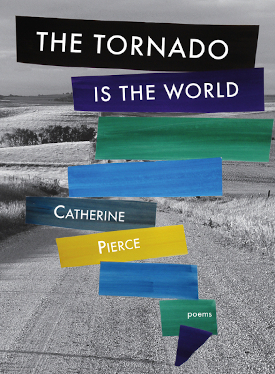
Pierce composed the poems in The Tornado Is the World in the aftermath of the 2011 Super Outbreak that left a swath of destruction through Alabama, Mississippi, Tennessee and other states. (Image: Courtesy of Catherine Pierce)
CURWOOD: So, why don't you read one of your tornado poems for us?
PIERCE: Sure. And this was the first poem that I wrote after that tornado experience. And so this is the one that is pretty autobiographical, at least in terms of what I was feeling in that moment. And in the book, the tornado takes on its own persona, because to me, it always feels like a tornado has agency. I always feel like it's making a decision about what it's doing, somehow. And so this poem addresses that. It's called The Mother Warns the Tornado.
I know I’ve already had more than I deserve.
These lungs that rise and fall without effort,
the husband who sets free house lizards,
this red-doored ranch, my mother on the phone,
the fact that I can eat anything—gouda, popcorn,
massaman curry—without worry. Sometimes
I feel like I’ve been overlooked. Checks
and balances, and I wait for the tally to be evened.
But I am a greedy son of a bitch, and there
I know we are kin. Tornado, this is my child.
Tornado, I won’t say I built him, but I am
his shelter. For months I buoyed him
in the ocean, on the highway; on crowded streets
I learned to walk with my elbows out.
And now he is here, and he is new, and he
is a small moon, an open face, a heart.
Tornado, I want more. Nothing is enough.
Nothing ever is. I will heed the warning
protocol, I will cover him with my body, I will
wait with mattress and flashlight,
but know this: If you come down here—
if you splinter your way through our pines,
if you suck the roof off this red-doored ranch,
if you reach out a smoky arm for my child—
I will turn hacksaw. I will turn grenade.
I will invent for you a throat and choke you.
I will find your stupid wicked whirling
head and cut it off. Do not test me.
If you come down here, I will teach you about
greed and hunger. I will slice you into palm-
sized gusts. Then I will feed you to yourself.

Debris and damage from the EF4 tornado that hit Cullman, Alabama on April 27, 2011 while Pierce and her family sheltered inside a Days Inn. (Photo: WildBamaBoy, Wikimedia Commons CC BY 2.0)
CURWOOD: How fair is it to say that the climate has given you PTSD?
PIERCE: Oh, very fair. [LAUGHS] I think that following the tornado experience, that was something that I hadn't realized that was what I was kind of working through in writing those poems. But it, but it was, and a lot of those poems deal very directly with that, with that feeling of not being able to see the world the way that you saw it prior to this event.
CURWOOD: And as a mother, how do your kids shape your writing about something that, well, it's in the process now of impacting their lives, and it'll be with them for a long, long time?

Danger Days, Pierce’s latest book of poetry, confronts climate disruption and other 21st century perils while bearing witness to the beauty in their midst. (Image: Courtesy of Catherine Pierce)
PIERCE: Absolutely. Well, so I, my book Danger Days came out in October of 2020. And that book deals a lot with climate crisis and a lot with parenting through climate crisis, and thinking about ways that I can try to, you know, hold these two ideas simultaneously. The idea of being afraid and angry and trying to take action on behalf of the planet; and genuinely celebrating and finding joy in all the marvels of our planet. And trying to impart that to my kids, trying to say, Yes, let's go out, and let's find these beautiful things. And look, there is a blue heron, and oh my gosh, let's find out what kind of flower this is. And so trying to kind of find that balance of not wanting to frighten my kids, but also wanting them to be informed, while still finding genuine joy in our amazing planet and all it has to offer.
CURWOOD: Catherine, there's another poem of yours that grapples with what some might even see as beauty in climate disruption. It's called Anthropocene Pastoral. Could you read that for us and set it up for us as well?
PIERCE: Absolutely. So this poem is called Anthropocene Pastoral, and I wrote it following the California superbloom of 2017, when the deserts in California were covered in just these gorgeous, gorgeous wildflowers, and people were flocking there to see them. And when I did some reading about this, I found that this was caused by, the region had had its worst dry spell in history. And then it was followed by twice the normal wintertime precipitation. And that led to this really beautiful event. And so I was thinking about that, as I was writing this poem about the ways that sometimes destruction can look like beauty, can be beauty in a way.

The 2017 southern California super bloom, seen here at Walker Canyon, inspired Pierce’s poem “Anthropocene Pastoral.” (Photo: Beau Rogers, Flickr CC BY-NC 2.0)
This is called Anthropocene Pastoral.
In the beginning, the ending was beautiful.
Early spring everywhere, the trees furred
pink and white, lawns the sharp green
that meant new. The sky so blue it looked
manufactured. Robins. We’d heard
the cherry blossoms wouldn’t blossom
this year, but what was one epic blooming
when even the desert was an explosion
of verbena? When bobcats slinked through
primroses. When coyotes slept deep in orange
poppies. One New Year’s Day we woke
to daffodils, wisteria, onion grass wafting
through the open windows. Near the end,
we were eyeletted. We were cottoned.
We were sundressed and barefoot. At least
it’s starting gentle, we said. An absurd comfort,
we knew, a placebo. But we were built like that.
Built to say at least. Built to reach for the heat
of skin on skin even when we were already hot,
built to love the purpling desert in the twilight,
built to marvel over the pink bursting dogwoods,
to hold tight to every pleasure even as we
rocked together toward the graying, even as
we held each other, warmth to warmth,
and said sorry, I’m sorry, I’m so sorry while petals
sifted softly to the ground all around us.
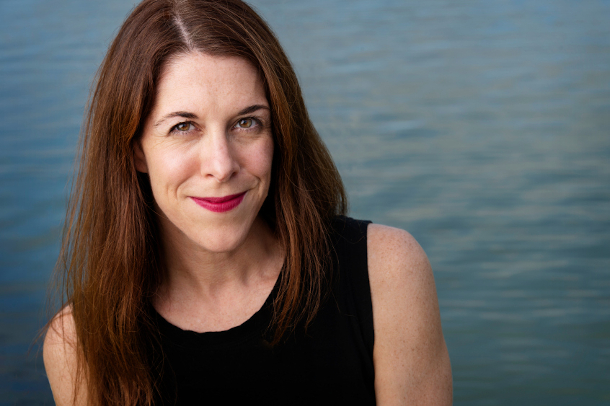
Catherine Pierce is the author of four books of poems including Danger Days and The Tornado Is the World and is professor of English and co-director of the creative writing program at Mississippi State University. (Photo: Megan Bean / Mississippi State University)
CURWOOD: Catherine, it sounds like you're in a way seeking permission to find beauty in, in what can happen during climate disruption to, quote, "hold tight to every pleasure." How do you think allowing ourselves to see this beauty in the midst of this emerging disaster is vital for our emotional resilience?
PIERCE: I think it's crucial for two reasons. One is, I mean, as you say, it's, it's vital for our emotional resilience, if we're not able to take joy and pleasure in these moments as we find them, how can we possibly be strong enough to do what we need to do? Which is, which is the other part of why it's necessary, we need to be able to recognize this beauty so that we can try to save it. Right, we need to feel spurred to action by our relationship with this planet and with everything that it offers us. We need art, we need beauty, we need poems, and walks in the woods and songs and essays, we need all these things, to allow us to feel the true pleasure that comes from paying attention to this world, which is just an absolutely remarkable place. But then we also need to feel strengthened by that into taking action, into trying to keep this amazing planet as something that our kids can explore with the same pleasure that we could, and that their kids hopefully can explore with the same kind of pleasure as well.
CURWOOD: Catherine Pierce is the author of Danger Days, The Tornado Is the World and other books of poems. Thanks so much for taking the time with us today.
PIERCE: Thank you so much for talking with me.
Related link:
Catherine Pierce’s poetry and more
[MUSIC: The Mount Vernon Virtuosi Cello Gang/Amit Peled, Medley: “Hallelujah/What a Wonderful World” on Around the World in Five Cellos, by Leonard Cohen/ Bob Thiele and George David Weissin, live at Baltimore’s Creative Alliance]
CURWOOD: Living on Earth is produced by the World Media Foundation. Our crew includes Naomi Arenberg, Paloma Beltran, Grace Callahan, Jenni Doering, Jay Feinstein, Paige Greenfield, Mark Seth Lender, Don Lyman, Aynsley O’Neill, Jake Rego, Natalie Seo, and Jolanda Omari.
BASCOMB: Tom Tiger engineered our show. Alison Lirish Dean composed our themes. You can hear us anytime at L-O-E dot org, Apple Podcasts and Google Podcasts, and like us, please, on our Facebook page - Living on Earth. We tweet from @livingonearth. And find us on Instagram at livingonearthradio. I’m Bobby Bascomb
CURWOOD: And I’m Steve Curwood. Thanks for listening!
ANNOUNCER: Funding for Living on Earth comes from you, our listeners, and from the University of Massachusetts, Boston, in association with its School for the Environment, developing the next generation of environmental leaders. And from the Grantham Foundation for the protection of the environment, supporting strategic communications and collaboration in solving the world’s most pressing environmental problems.
ANNOUNCER 2: PRX.
Living on Earth wants to hear from you!
Living on Earth
62 Calef Highway, Suite 212
Lee, NH 03861
Telephone: 617-287-4121
E-mail: comments@loe.org
Newsletter [Click here]
Donate to Living on Earth!
Living on Earth is an independent media program and relies entirely on contributions from listeners and institutions supporting public service. Please donate now to preserve an independent environmental voice.
NewsletterLiving on Earth offers a weekly delivery of the show's rundown to your mailbox. Sign up for our newsletter today!
 Sailors For The Sea: Be the change you want to sea.
Sailors For The Sea: Be the change you want to sea.
 The Grantham Foundation for the Protection of the Environment: Committed to protecting and improving the health of the global environment.
The Grantham Foundation for the Protection of the Environment: Committed to protecting and improving the health of the global environment.
 Contribute to Living on Earth and receive, as our gift to you, an archival print of one of Mark Seth Lender's extraordinary wildlife photographs. Follow the link to see Mark's current collection of photographs.
Contribute to Living on Earth and receive, as our gift to you, an archival print of one of Mark Seth Lender's extraordinary wildlife photographs. Follow the link to see Mark's current collection of photographs.
 Buy a signed copy of Mark Seth Lender's book Smeagull the Seagull & support Living on Earth
Buy a signed copy of Mark Seth Lender's book Smeagull the Seagull & support Living on Earth

